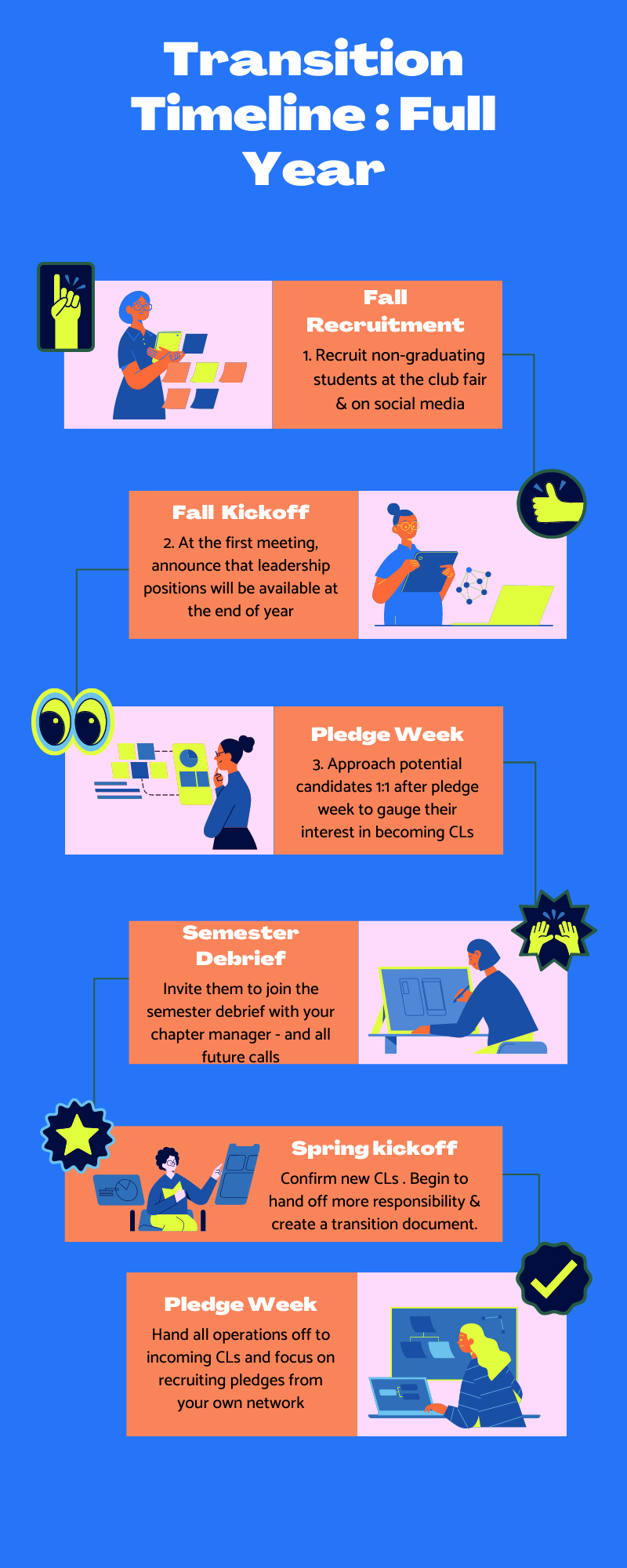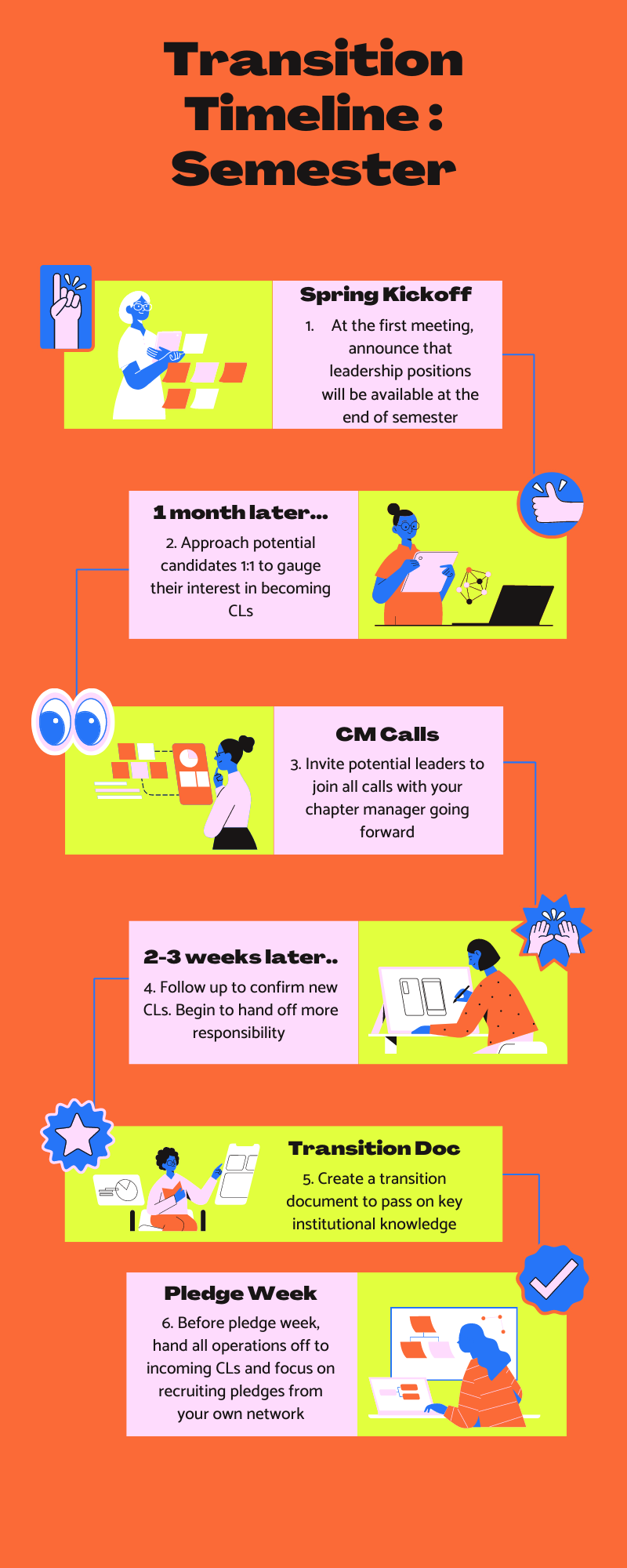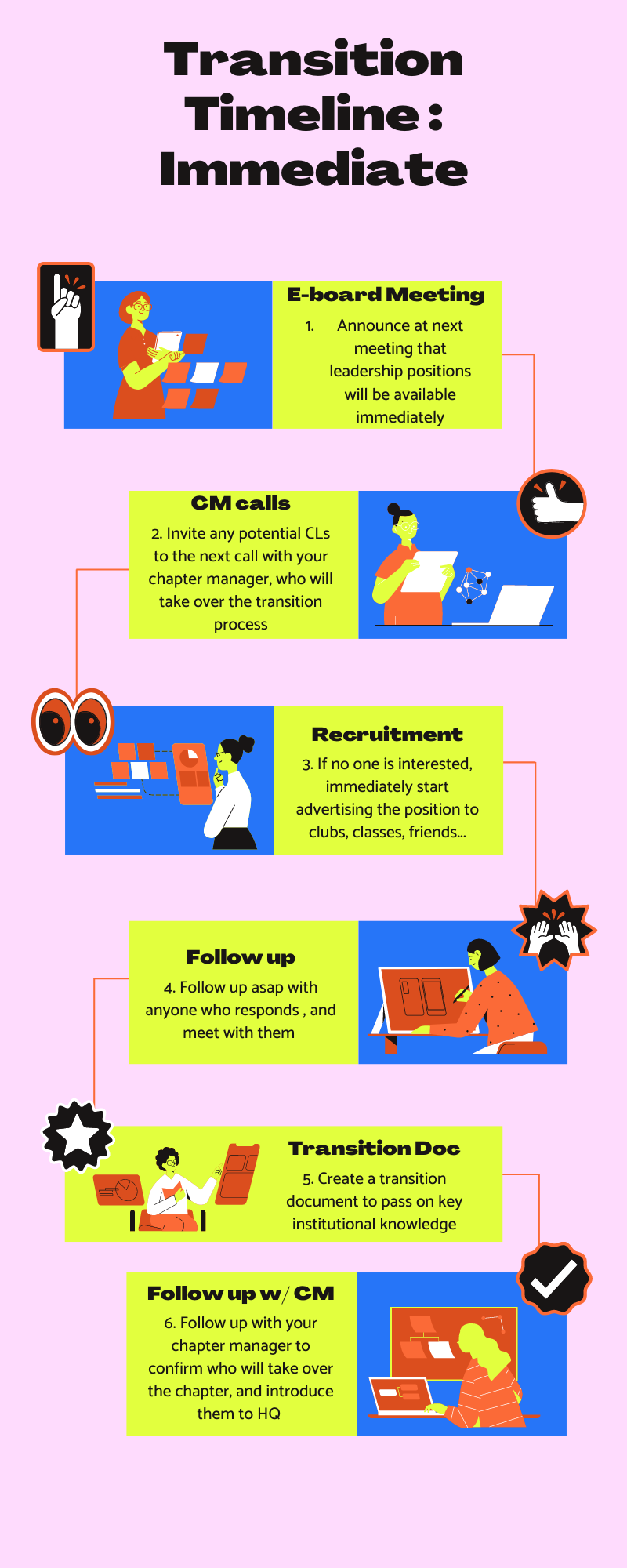Reproducing leadership is one of the most challenging tasks in any organizing setting. Often, Chapter Leaders are so focused on short-term pledge goals that they underestimate how much time and effort it takes to identify and upskill future leaders who will someday run the chapter. To ensure that our chapters continue to thrive and grow once we step down, it’s crucial to have a solid plan for this transition. This article lays out a suggested step-by-step approach for executing leadership transition, as well as best practices for leadership transition.
Contents:
Sample Transition Timelines
This section lays out sample timelines for transition under three scenarios:
- Best Case - Full Year Transition: you have an entire academic year to execute transition. This means that you begin the transition process as soon as the year starts.
- Contingency - Semester Transition: you have one semester to execute transition.
- Emergency - Immediate Transition: you are unable to run the chapter and need to hand it off to different leaders immediately.
Best Case: Full-Year Transition
Fall semester:
- Recruit non-graduating students during your recruitment cycle.
- Target some of your recruitment outreach towards first and second year classes. In particular, maintaining an energetic presence at your fall Club Fair is the most important step for achieving this. With sufficient signups at the Club Fair, you should be able to recruit multiple first- and second-year students. You should also utilize class year social media pages (eg Class of 2024 Facebook page), ask first year reps in student government to send to their mailing lists, and ask to make announcements in larger lecture classes populated predominantly by younger students.
- During your first team meeting of the year, announce that leadership positions will be available at the end of the year. Note that you will be looking for board members who demonstrate exemplary diligence and dedication, and be sure to talk up the benefits of being a Chapter Leader. Here’s a sample blurb to use:
- "As many of you are aware, [co-president] and I will be stepping down at the end of the year. This means there are exciting leadership opportunities coming up in the spring term. Throughout the year, we’ll be looking out for diligent, dedicated, promising board members who distinguish themselves by recruiting pledges and prioritizing their work with the chapter, and approaching them as candidates for future leadership. If you’re interested in the opportunity to lead our chapter and build on our success this year, be sure to keep this in mind – you can reach out to me or [co-president] with questions. We will get in touch with folks who seem like good candidates toward the end of the term."
- Build relationships with and evaluate the skills of the executive board.
- Who shows up to every meeting and is always keen to take on more responsibility?
- Approach potential candidates 1:1 prior to or immediately following Fall Pledge Week to gauge their interest in becoming a Chapter Leader. They don’t need to commit following the first conversation, which can be largely to test the waters, but you should come out of this conversation with a sense of whether they’re interested.
- Invite prospective incoming Chapter Leaders to join semester debrief and all calls with the Organizing Manager going forward.
Spring semester:
- Confirm new Chapter Leaders for the coming year. Gradually hand off more responsibility to these incoming leaders, working closely with them to upskill them in their specific areas of responsibility.
- Make a list of all the weekly tasks you do, then introduce your incoming CLs to a new item on this list each week. For example:
- E-board meetings: Writing the agenda, running the meeting, following up as necessary.
- Internal organizing: Following up 1:1 with members under your direct supervision throughout the week to get updates on their tasks and their potential pledgers; designing and running onboarding sessions and other trainings; holding interviews with prospective members; organizing logistics for tabling and events.
- External organizing: Making announcements in class; giving a speech at an event; meeting with leaders of other clubs to discuss collaboration.
- Admin: Liaising with university staff as necessary; ensuring club paperwork is up to date.
- Make a list of all the weekly tasks you do, then introduce your incoming CLs to a new item on this list each week. For example:
- Create a transition document to pass on key institutional knowledge to your successors (see template transition guide below).
- Prior to Spring Pledge Week, hand all operations off to incoming Chapter Leaders so that they can practice running the chapter with supervision, and outgoing Chapter Leaders can focus on recruiting pledges from their own networks.
Contingency: Single-Semester Transition
- During your first team meeting of the semester, announce that leadership positions will be available at the end of the term. Note that you will be looking for board members who demonstrate exemplary diligence and dedication, and be sure to talk up the benefits of being a Chapter Leader. Here’s a sample blurb to use:
- "As many of you are aware, [co-president] and I will be stepping down at the end of the year. This means there are exciting leadership opportunities coming up in the spring term. Throughout the year, we’ll be looking out for diligent, dedicated, promising board members who distinguish themselves by recruiting pledges and prioritizing their work with the chapter, and approaching them as candidates for future leadership. If you’re interested in the opportunity to lead our chapter and build on our success this year, be sure to keep this in mind – you can reach out to me or [co-president] with questions. We will get in touch with folks who seem like good candidates toward the end of the term."
- Build relationships with and evaluate the skills of the executive board.
- Who shows up to every meeting and is always keen to take on more responsibility?
- Approach potential candidates 1:1 no more than one month after the start of the semester. They don’t need to commit following the first conversation, which can be largely to test the waters, but you should come out of this conversation with a sense of whether they’re interested.
- Invite prospective incoming Chapter Leaders to join calls with your Organizing Manager going forward.
- Follow up 2-4 weeks later to confirm new Chapter Leaders for the coming year. If the people you originally approached are not interested, approach your next best e-board members. Gradually hand off more responsibility to these incoming leaders, working closely with them to upskill them in their specific areas of responsibility.
- Make a list of all the weekly tasks you do, then introduce your incoming CLs to a new item on this list each week. For example:
- E-board meetings: Writing the agenda, running the meeting, following up as necessary.
- Internal organizing: Following up 1:1 with members under your direct supervision throughout the week to get updates on their tasks and their leads; designing and running onboarding sessions and other trainings; holding interviews with prospective members; organizing logistics for tabling and events.
- External organizing: Making announcements in class; giving a speech at an event; meeting with leaders of other clubs to discuss collaboration.
- Admin: Liaising with university staff as necessary; ensuring club paperwork is up to date.
- Create a transition document to pass on key institutional knowledge to your successors (see template transition guide below).
- Prior to Spring Pledge Week, hand all operations off to incoming Chapter Leaders so that they can practice running the chapter with supervision, and outgoing Chapter Leaders can focus on recruiting pledges from their own networks.
Emergency: Immediate Transition
- Announce at your next e-board meeting that leadership positions will be available immediately. Reach out to all of your board members individually gauging their interest in taking over the chapter. Note that you will be looking for board members who demonstrate exemplary diligence and dedication, and be sure to talk up the benefits of being a Chapter Leader.
- Invite prospective incoming Chapter Leaders to join your next call with your Organizing Manager, who will take over the leadership transition process.
- If no one is interested, share this blurb to 5-10 listservs, at least 5 other clubs, and with as many of your friends as possible:
- “Hi, my name is [your name] and I’m the former leader of the One for the World chapter at [university]. One for the World is a global movement of students and young professionals working together to end extreme poverty by spreading awareness and inviting people to take the One for the World pledge. We are looking for altruistic and ambitious individuals to run the chapter next year. This is a great opportunity to build leadership experience and save lives. If you’re interested in learning more, please fill out this form [link form]. Thanks!”
- Follow up with your Organizing Manager to confirm whether anyone got in touch to take over the chapter.
Best Practices
Ensure that your chapter always has two Chapter Leaders.
- Running a chapter can be a lot of work. A co-leader (often called Co-President) who matches your effort and dedication, and whom you can depend on to complete the work they take on, will greatly boost your chapter's growth and make your experience running the chapter significantly better.
Aim to run your chapter for one year, and certainly for no more than two years.
- You will risk burning out if you run your chapter for much longer than one year. This means you should constantly be looking for your replacements, starting from the beginning of your first fall term running the chapter.
Look for potential successors early and often.
- The academic year moves quickly, and before you know it Pledge Week will be upon you. It's important to constantly be looking for dedicated, talented people to start developing as future leaders. Recruit some non-graduating students in your fall recruitment cycle, start building relationships with them early on (e.g., grab a coffee with them, meet with them for 30 minutes before the regular exec board meeting, invite them to all the OFTW HQ trainings and conferences, etc.), delegate tasks and projects to them, and approach them by Pledge Week of your fall semester to gauge their interest in taking over the chapter when you step down.
An incoming Chapter Leader should ideally be paired with an experienced Chapter Leader.
- Incoming Chapter Leaders should have a 'trial semester' that overlaps with an outgoing Chapter Leader’s tenure where they take on significant work without officially taking over the chapter, in order to upskill them and evaluate their ability to lead and willingness to prioritize One for the World. This includes bringing them to your calls with your Chapter Manager, as well as handing off various parts of chapter operations to them. Be sure to give them guidance on how to execute these responsibilities rather than handing them off directly. For example, incoming Chapter Leaders could:
- Draft e-board meeting agendas and run the meetings
- Make introductory remarks at your next event
- Hold 1:1 interviews with prospective members
- Design and/or run one meeting in your new member onboarding series
- Run tabling logistics for a mid-semester tabling shift or for part or all of Pledge Week (deciding shift times and locations, creating a shift signup form, identifying leads for each shift, etc.)
Chapter Leaders must prioritize One for the World as an extracurricular.
- All students face competing demands on their time. Chapter Leaders typically must prioritize One for the World as one of their main extracurricular activities for the chapter to be successful. If they are not able to make One for the World their extracurricular priority, you should immediately begin looking for someone else to take the chapter over. Chapters struggle and typically shut down when their core members do not prioritize One for the World. Prioritizing the chapter means dedicating an average of 2-4 hours a week to ensuring the healthy function of the club: running e-board meetings; recruiting and training new members; holding regular tabling; giving presentations and running events; having regular calls with your Organizing Manager; attending OFTW HQ trainings, workshops, and the once-a-semester Chapter Leaders’ Meeting.
Chapter Leaders should generally not be first-year students, particularly for undergraduate chapters.
- The class-year distribution of pledge recruitment tends to follow the class-year distribution of chapter membership, as the core growth model for chapters is to recruit organically from members' networks. There is also a clear relationship in our data between length of pledge delay (how many years after pledging the person's donations will actually start) and probability of converting to a donor (i.e., not canceling or experiencing a payment failure prior to activation). If your chapter's membership primarily comprises of first-year students, your pledges will necessarily have greater risk of canceling and will have a lower discounted run rate. Moreover, older students typically have more developed networks to reach out to throughout the semester, increasing your chapter's reach.
At least one co-president should not be a graduating student.
- Running a chapter is difficult when you also have to contend with an upcoming graduation. Certainly, chapters have performed very successfully under graduating students in the past (Wharton and Columbia were both run by graduating students in 2019, as well as Harvard Law in 2021), but this requires prioritizing One for the World and carefully balancing it with your other priorities even more so than for co-presidents of other class years. While it is very important to have graduating students involved with the chapter in order to recruit more pledges from other graduating students (i.e., pledges with a shorter delay), to mitigate the risk of Chapter Leaders becoming overwhelmed and reneging on running the chapter, ensure that at least one co-president is not a graduating student. For MBA chapters, this means 2nd-years; for Law chapters, 2nd-years may be ideal; for Undergrad chapters, 2nd- or 3rd-year students (sophomores and juniors) may be best.
Create a leadership transition guide to ensure the transmission of crucial information about the chapter.
- This document should include key contact information, passwords and other credentials, guidance on keeping the club registered and securing funding from your university, a list of clubs your chapter has developed relationships with (including contact information), lessons learned, and any other information that you think is vital to the chapter's healthy function.
Develop a formal application process as necessary. For MBA and Law chapters in particular, consider an interview stage with your candidates.
- Sometimes, a formal application process can increase the perceived prestige of the position. It also encourages candidates to take the position more seriously, and gives you an extended chance to vet them. An application form with an interview will help you better gauge the candidate's dedication to One for the World and suitability for the position of Chapter Leader. One for the World HQ is available to help with interviews where appropriate -- contact your Chapter Manager for more information.


